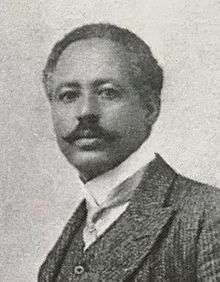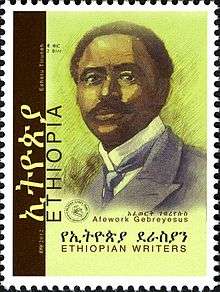Afevork Ghevre Jesus
Afäwarq Gäbrä Iyäsus (Amharic: አፈ ፡ ወርቅ ፡ ገብረ ፡ ኢየሱስ; misspelled in Italian: Afevork Ghevre-Jesus or Āfeworq Gebre Īyesūs; misspelled in English Afewark Gebre Iyasus; July 10, 1868 – September 25, 1947) was an Ethiopian writer, who wrote the first novel in Amharic, Ləbb Wälläd Tarik (A Heart [better “Intellect”]-born Story), (Italian: Libb Wolled Tarik). Bahru Zewde writes, "Few people before or after him have demonstrated such superb mastery of the Amharic language. Few have ventured with such ingenuity into the hidden recesses of that language to come out with a wealth of vocabulary and idiom one scarcely thought the language possessed.[1] Afäwarq is nonetheless a controversial figure for having supported the Italians during both the First and Second Italo-Abyssinian Wars.[2]


Biography
Afäwarq was born in Zegé on the southern shore of Lake Tana. He received a traditional education from the church of Ura Kidana Mehrat under the direction of his grandfather Manher Denqe, whom Bahru Zewde describes as "a noted scholar." He also practiced painting in the traditional Ethiopian style.[3]
Afäwarq was also related to the Empress Taytu Betul, and it apparently was through her that he was introduced to Emperor Menelik II's court sometime after 1880. It was there he came to the attention of the Italian diplomat Count Pietro Antonelli, who was impressed with his artistic abilities and enabled him to study in Italy. Afäwarq left for Italy September 1887, was admitted to the International Institute in Milan, where he attended classes in painting at the Albertina Academy of Fine Arts. During his studies in Milan he was called to be the official interpreter for the Ethiopian delegation headed by then Dejazmach Makonnen Wolde Mikael. Afäwarq later claimed that it was he who pointed out the infamous discrepancy between the Amharic and Italian versions of article XVII of the Treaty of Wuchale.[4]
He returned to Ethiopia, arriving in Addis Ababa 11 July 1890, at a time when his Italian connections only made the Empress disfavor him. Afäwarq's relationship with Taytu only worsened, so he was relieved when he was asked in September 1894 to escort two men to Neuchatel in Switzerland where they had been enrolled at the International School. By this time Afäwarq had also married the daughter of Alfred Ilg by an Ethiopian wife. It was while in Switzerland that Afäwarq first sided with Italy over his homeland, crossing over to Italy with his two charges and putting all three at the service of the Italian authorities. The Italians quickly sent them to the war front; they arrived at Massawa 6 January 1896, but despite Italian plans and intentions nothing of consequence came of this misadventure, and the three men were at Asmara when the Italians were defeated at Adwa.[5]
Afäwarq returned to Italy, and the next 16 years, as Bahru Zewde states, witnessed "some of the most important literary and intellectual accomplishments of his career. These included a work on Amharic grammar, an Italian-Amharic conversation manual, the satirical Guide du voyageur, and the novel Ləbb Wälläd Tarik, published in Rome in 1908, widely considered the first novel in Amharic,[6] about Waḥəd and his sister Ṭobiya, under the name Afevork Ghevre Jesus. He also worked with the Italian Ethiopicist Francesco Gallina at this time.[7]
In 1912, Afäwarq moved to Eritrea where he established an import-export business. On the death of Emperor Menelik, he attempted to ingratiate himself with his successor, Emperor Iyasu V, by writing poems lauding the young man; when Iyasu was deposed in a coup four years later, writes Bahru Zewde, "With the amazing dexterity for volte-face that was to be the hallmark of his career and character, Afäwärq composed an equally condemnatory poem on Iyyasu."[8] This latter tactic apparently succeeded in reconciling him with the new authorities, for in 1917 or 1918 he was back in Addis Ababa. By 1922 he had become the Nagadras of Dire Dawa in 1922, then between 1925 and 1930 Afaworq served as president of the special court that heard cases involving foreigners and Ethiopians. He was appointed charge d'affairs in Rome for the Ethiopian government, a position which Bahru Zewde notes that, due to "his known predilection for the Italians and his record of treason" might not have made him the best candidate for this position, but Bahru goes on to quote the American representative in Ethiopia, Addison E. Southard, who observed Haile Selassie wanted "to get rid of Afawork locally who has the reputation for being an obstreperous and fire-eating old gentleman with potentialities for stirring ... trouble."[8] Regardless of his deeper allegiances, Afawork found himself in a difficult situation, being forced to rely on the Italian Ministry of Foreign Affairs to send his telegrams home.[9]
He returned to Ethiopia shortly before the beginning of the Second Italo-Abyssinian War, but upon the Italian forces entering Addis Ababa he acquiesced to their rule, christening 5 May 1936 as the beginning of the "Era of Mercy" for Ethiopia. Despite his loyalty to the Italian cause, in the backlash that followed the attempt on Graziani's life he was arrested and deported to Italy. He was not allowed to return to Ethiopia until 1938, after which he served usefully enough to be made Afa Qesar ("Mouthpiece of the Caesar") 9 May 1939. However, upon Haile Selassie's return to Ethiopia, Afaworq was arrested by the restored Ethiopian government, tried for treason, and sentenced to death—a sentence subsequently commuted to life imprisonment. He was exiled to Jimma where Afaworq, by then blind, died.[9]
Works
- ልብ ፡ ወለድ ፡ ታሪክ ። (Ləbb Wälläd Tarik) [A Heart-Born Story]. Rome 1908.[10]
- ዳግማዊ ፡ ምኒልክ ፡ ንጉሠ ፡ ነገሥት ፡ ዘኢትዮጵያ ። (Dāgmāwī Minīlik Nigūse Negest ze-'Ītyōṗyā) [Menelek II, King of Kings of Ethiopia]. Rome 1909; second edition, Dire Dawa 1919.
Linguistics
- Manuale di conversazione italiano-amarico con la pronuncia figurata. Rome 1905.
- Grammatica della lingua amarica. Metodo practico per l'insegnamento. Rome 1905.
- Guide du voyageur en Abyssinie. Rome 1908.
- Il verbo amarico. Rome 1911.
References
- Bahru Zewde (2002). Pioneers of change in Ethiopia (1. publ. ed.). Oxford: J. Currey. p. 158f. ISBN 0852554524.
- Richard Pankhurst Graziani: The Aftermath in The Secret History of the Italian Fascist Occupation, 1935–1941, 9. Addis Tribune (Addis Ababa)
- Bahru Zewde, Pioneers, p. 52
- Bahru Zewde, Pioneers, pp. 52f
- Bahru Zewde, Pioneers, pp. 53f
- Admassu, Yonas. 2003. "Afäwarq Gäbrä Iyäsus." In Encyclopaedia Aethiopica: A-C: Vol. 1, edited by Siegbert Uhlig, 122–124. Wiesbaden: Harrassowitz Verlag.
- Bahru Zewde, Pioneers, p. 54
- Bahru Zewde, Pioneers, p. 55
- Bahru Zewde, Pioneers, p. 56
- For a summary and brief discussion of this 90 page work see Jack Fellman, "Ethiopia's First Novel", in: Research in African Literatures 22 (1991), pp. 183–184.
- See Zerihun Asfaw, Libbwolled Āwāǧ innā Lēlōčč Āč̣āč̣č̣ir Tārīkōčč ke-qeddemt ye-Ītyōṗya derāsyān 1898–1949 ["Libbwolled Āwaǧ" and other short stories by early Ethiopian writers] (Addis Ababa: 2003), pp. 1–3.
- See Zerihun Asfaw, Libbwolled Āwāǧ, pp. 4–5
Further reading
- Bahru Zewde (1994), review article of Alain Rouaud 1991 (see below), in: The International Journal of African Historical Studies 27/1, pp. 224–226.
- Luigi Fusella (1951), "Il Lebb wallad tarik", in: Rassegna di studi etiopici 10, pp. 56–70.
- Luigi Fusella (1961–1963), "Il Dagmawi Menilek di Afawarq Gabra Iyasus", in: Rassegna di studi etiopici 17, pp. 11–44; 19, pp. 119–149.
- Luigi Fusella (1984), "Le premier romancier Ethiopien", in: Luigi Fusella, Salvatore Tedeschi & Joseph Tubiana (eds.), Trois essais sur la littérature éthiopienne. Paris.
- Alain Rouaud (1982), "Pour une bibliographie des oeuvres d'Afä Wärq Gäbrä Iyäsus", in: Bulletin des études africaines 2–3, pp. 123–136.
- Alain Rouaud (1991), Afä-Wärq, un intellectuel éthiopien témoin de son temps 1868–1947. Paris. ISBN 2-222-04513-4.
- Yonas Admassu (2003), "Afäwärq Gäbrä Iyäsus", in: Siegbert Uhlig et al. (eds.), Encyclopaedia Aethiopica, Wiesbaden: Otto Harrassowitz, vol. 1 (A-C), pp. 122b-124a.
External links
- Richard Pankhurst, Ethiopian Artists of Yester-year, Part 1: From AFAWARQ GABRE IYASUS to FERE SEYON in the Addis Tribune website.